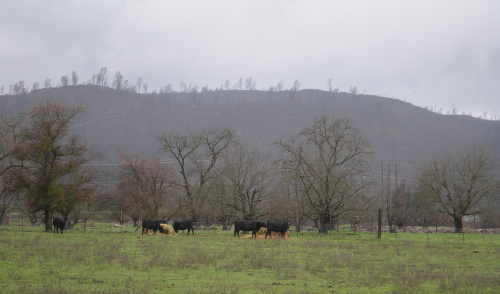
“A nation that forgets its past can function no better than an individual with amnesia.” – David McCullough
LAKE COUNTY, Calif. – Cattle are not native to California or, for that matter, North America, but were introduced to these lands by the Spanish during the mission era.
According to the “Historical and Descriptive Sketchbook of Napa, Sonoma, Lake and Mendocino”, by C. A. Menefee, 1873, “The first farming (in Lake County) was commenced in 1854.”
Menefee added, “Stock raising is the chief source of natural wealth outside of the mines. The hills are devoted to stock, and so much of the valleys as are not used for the production of grain ... Around the lake are some of the finest dairies anywhere to be found. Butter and cheese are produced and shipped in large quantities. The rich land bordering the lake seems especially adapted to grazing. Clear Lake cheese is recognized in the markets as the finest that can be found.”
Problems arose prior to the “first farming of 1854” in Lake County due to the raising of cattle. From the introduction to my novella, “People of the Water,” a fictional account of the events leading up to the Bloody Island Massacre of 1850:
“Like many Indians in California, the Pomo Indians of the Clear Lake Basin in California were run off of their tribal, ancestral lands, forced to work the ranches or Missions, beaten and massacred. Charles Stone and Andrew Kelsey purchased stock from Salvador Vallejo, and garnered permission to use his land for grazing. Kelsey and Stone mistreated Indians to the extreme – they starved, beat, and worked them to death.
“It was common knowledge in nearby settlements that Stone and Kelsey were cruel to the Indians. The Indians could no longer tolerate the hunger and the beatings, so they killed some cattle for food. This incident did not bode well with Stone and Kelsey.
“Many more atrocities ensued – one Indian was tied to a tree then beaten, some Indian homes were burned down, and others were marched to the gold fields where most perished due to exposure and starvation. Added to those heartrending incidents was the fact that Chief Augustine’s wife was kidnapped and forced to live with the white men.
“So, in the fall of 1849, Stone and Kelsey were murdered by Indians. In the spring of 1850, a detachment of the United States troops led by Captain Nathaniel Lyon was sent from the San Francisco Presidio or Benicia with whaleboats hauled by wagons, along with cannons, in retaliation for Stone and Kelsey’s deaths. Pomo people in their village of Badonnapoti on what is now called Bloody Island, in Clear Lake, California were targeted and massacred by the soldiers.
“Women and children were killed indiscriminately – soldiers chased them into the water, bludgeoning and shooting them. This massacre was replayed again and again over the course of a month as the soldiers continued killing Indians, working their havoc westward toward Ukiah.
“The United States government concluded its tyranny in 1851 by drafting a treaty and trying to initiate a rancheria. The treaty, like so many others, was never ratified. The site is marked by California State Historical marker number 427, located at the intersection of State Highway 20 and Reclamation Road, 1.7 miles southeast of Upper Lake marks the area, once an island, where this story took place. The brutality of the Bloody Island Massacre and similar atrocities to other tribes is a grievous legacy. The courage of the Pomo people lives on forever.”
Another atrocious practice involving cattle was that of “baiting the bulls.”
According to Henry Mauldin, “Large grizzly bears were often found in California during this period. When a group of riders approached one of these bears, he would be lassoed by each of the riders until he was in a web-like tangle of lariats and quite helpless. With the bear held captive other riders would go in search of a Long Horn bull. When found, it too would be lassoed and taken to where the bear was. A short piece of rope would then be secured, one end to the bull and the other to the bear. All other possible lariats would be removed. By that time both animals were angry, full of fight and well matched in ability. Always one or the other was killed and many times both failed to survive.
“When the soldiers came over the trail from Hopland, at a point near the Riggs place on Scotts Creek (in 1851), the men found the remains of both a Long Horn and a grizzly bear where they had died from “Baiting of the Bulls”, the only known incident of that kind in Lake County. It was thought to have taken place by a visit of Spanish-Americans from their Mexican land grant at Hopland.”
Cattle, or stock in Lake County included the “longhorn” variety, so named due to their wide horns which can span up to 7 feet, tip-to-tip. This breed was quite hardy and was able to thrive on poor quality feed and not much water. They were popular for their hides and tallow.
In 1907 our county farm advisor estimated there were around 15,000 head of cattle in Lake County.
The varieties included Hereford, polled Hereford, Scotch Highland, Angus, shorthorn and Galloway cattle. The Angus variety arrived in Lake County in 1943.
Kathleen Scavone, M.A., is an educator, potter, writer and author of “Anderson Marsh State Historic Park: A Walking History, Prehistory, Flora, and Fauna Tour of a California State Park” and “Native Americans of Lake County.” She also writes for NASA and JPL as one of their “Solar System Ambassadors.” She was selected “Lake County Teacher of the Year, 1998-99” by the Lake County Office of Education, and chosen as one of 10 state finalists the same year by the California Department of Education.

 How to resolve AdBlock issue?
How to resolve AdBlock issue? 



